Dogs may not speak, yet they communicate with one another.
Their primary mode of communicating is through body language. For example, a dog’s ears and tail placement might reveal a lot about him. Some vocalizations, however, also play a function.
Dogs comprehend this shared language by combining intrinsic knowledge and learning, similar to how humans understand facial emotions. They are wired to communicate with us. Learning helps you understand other people better. However, most people are born with an inherent ability to interpret the cues of others.
Understanding our dog’s body language, on the other hand, does not come readily to us. As a result, many individuals misunderstand their dog’s body language. A wagging tail, for example, does not necessarily indicate that a dog is content.
This misconception can lead to harmful circumstances, such as mistaking a nervous dog for the one that is fine.
Learning how a dog communicates can be quite beneficial. It is something that every dog owner should be aware of.
Do you have a specific question about learning how do dogs communicate with each other? Then use the table of contents below to jump to the most relevant section. And you can always go back by clicking on the black arrow in the right bottom corner of the page. Also, please note that some of the links in this article may be affiliate links. For more details, check the Disclosure section at the bottom of the page.
Here's what we'll cover:
How do dogs communicate?
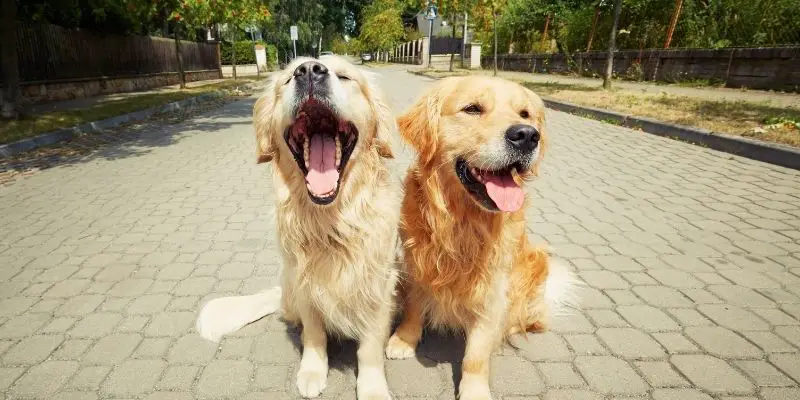
And can dogs understand each other? You’ll need to use the same learning approaches you’d use to master a foreign language to assist you find out the numerous ways dogs communicate about various things. Dogs and humans use many of the same basic communication strategies.
Canines can communicate with other dogs through various means, including vocalizations, body language, and odors. Dogs, like humans, are incredibly friendly creatures that live in close proximity to one another. Therefore they must have a dog language that allows them to communicate with one another. In fact, dog language is frequently used in dispute mediation, helping to keep the peace by sending out calming signals.
By scent
This is most likely the least understood of the dog communication signals. Smells are a great technique to communicate with dogs because their sense of smell is significantly stronger. To put things in perspective, they have 300 million olfactory receptors, but humans only have 6 million, making it 50 times more significant!
They smell other dogs to learn more about them, for example, since their scent might reveal their age, gender, and status in the group, which is essential information. This includes humans because your pet can detect your mood based on your scent. And when it comes to smells and scents you can be sure: all dogs speak the same language.
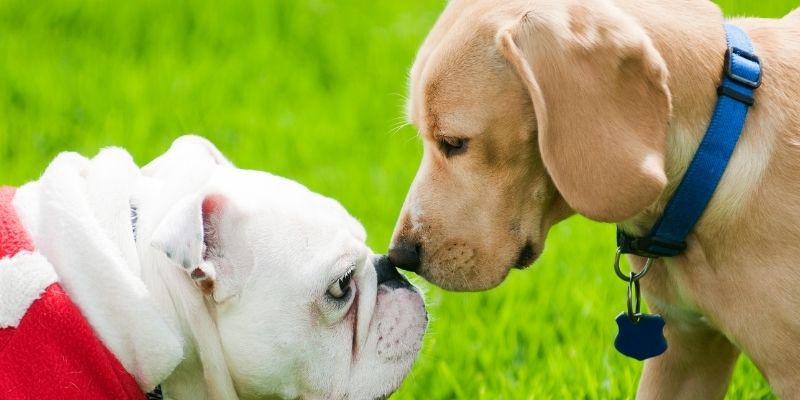
The Urine – The Canine Finger Print
Did you realize that canine urine carries odors as distinct as human fingerprints? As a result, they are a terrific means of communication and a tremendous source of information. In this study, for example, scientists discovered that bush dogs can distinguish the sex of another dog based just on the smell of its pee.
Now you know why dogs smell fire hydrants, trees, shrubs, electric poles, and wherever else a dog might have peed. When your dog does it, it picks up on critical messages left by other dogs, such as how many dogs have been in that designated area or whether there is a nearby female in heat.
Urine is especially vital during heat because a female dog’s urine carries unique pheromones that alert male canines that she is in season. As a result, pee is the most effective means to communicate via odors and scents.
Beyond urine
Although urine is one of the most essential scent-based communication channels, it is not the only one. Stools, saliva, and anal glands can all contain data used to send crucial messages. Now you know why your dog pauses to sniff stools you encounter when walking it or why dogs stop to smell each other’s backsides.
Hearing and sound
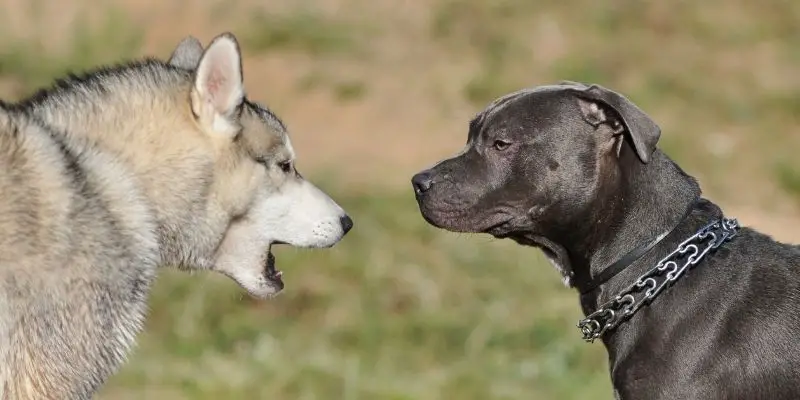
The most obvious way for dogs to communicate with each other and with humans is through sound and barking. But do dogs talk when they bark?
Following the scent, noises are the preferred mode of communication between dogs. They make more noise than merely barking. Here is the whole list:
Growling
Contrary to popular assumption, growing is not usually a precursor to violence. Instead, it can mean a variety of things, and we’ll look at some examples below:
When your dog growls fiercely and loudly and displays defiant body language such as flashing off its fangs, it prepares to attack if you, another dog, or another animal persists in whatever they are doing. So keep an eye out for this indicator when walking or socializing with your dog.
When dogs are playing, they tend to growl. However, they often growl quietly and without aggression. Its body language will be comfortable and lively; it will exude a relaxed and fun attitude.
When your pet is happy, it may growl too. It’s a common scenario when you’re patting and stroking it. Rottweilers, for example, are more prone to this tendency than other breeds. They simply want to express how fantastic it feels.
Howls
Yip-howl — lonely and in need of company.
Howling – signifies the dog’s presence or that this is its territory.
Bark-howl, 2-3 barks followed by a melancholy howl — the dog is generally lonely, shut away with little companionship, and is requesting company or a reaction from another dog.
Baying – can be heard when tracking to summon pack members to the quarry.
Barking
The most common and important sound, capable of expressing a wide range of emotions:
It is sharp and strong, and it is often staccato in nature. This is because they want to warn you about something strange or harmful.
Boredom is characterized by repetition and monotony. It seemed that it would never end. They exhibit this behavior when they are not given enough physical and mental stimulation.
Fear is audible, insistent, and frustrating. It embodies terror across the board. It is common when your dog has not been properly socialized because even basic household objects might set it off. The same is true for other canines, animals, and humans.
The sound of distress is recurrent, persistent, and high-pitched. In addition, it is typical for dogs to have separation anxiety.
It just sounds like fun. Tonality is normal, pitch is average, and it is not repetitious. It is used by dogs while they are enjoying the fun.
You now understand that it can mean many things based on the pitch, tone, and circumstance. Now that you’re aware of common conditions, you can do short repairs to address issues such as boredom barking. And if you are wondering: “can dogs understand other dogs?”, with that range they definitely can.
Whining and whimpering
Whining and whimpering are short, high-pitched sounds intended to entice the listener to demonstrate fear or obedience on the whiner’s or whimperer’s behalf. These are also the sounds that puppies produce to calm and attract their owners.
Soft whimpering and whining — pain or fear.
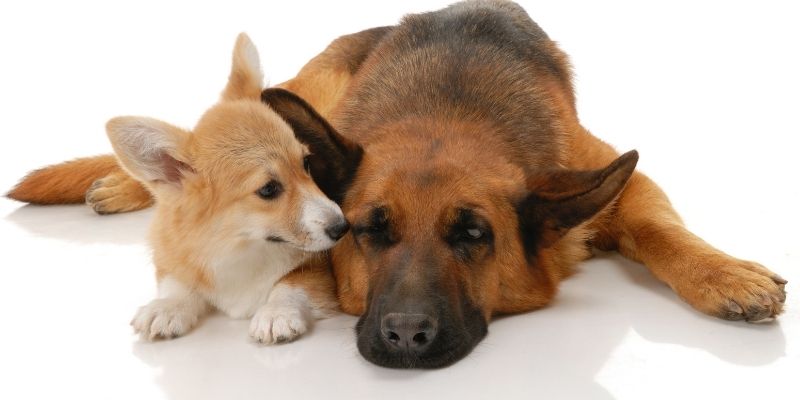
Lower pitched than whines or whimpers, moans or moan-yodel – spontaneous pleasure or enthusiasm.
Response to sharp, unexpected pain, such as a too-hard play bite, with a single yelp or high-pitched bark.
A series of yelps indicates extreme anxiety or discomfort.
Tactile communication
Tactile communication is an essential part of dog communication that is infrequently investigated. Tactile communication between dogs is used during agonistic interactions to impress an opponent. It can be done via intense physical contact, placing paws over the back or body of the subordinate, grabbing the subordinate’s or young individuals’ muzzles, and clasping another canid during ritualized aggression.
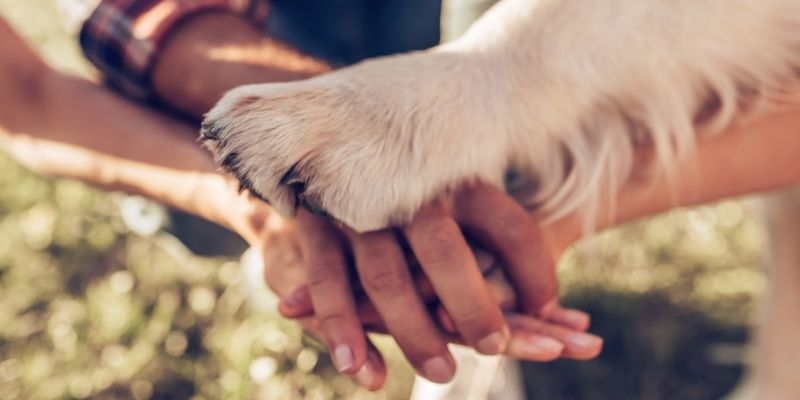
It can also be used to maintain the social bond. Specific activities, such as resting in close contact, placing the head over the shoulders of another dog during greetings or sexual approaches preceding mating, and social grooming, which generally includes “face washing” (licking the other animal’s face) or “nibble” grooming, using the front teeth and rapid jaw open-close movements, help to maintain social cohesion.
Similarly, some human gestures during human-dog physical interaction may result in good or negative canine emotional states, which drive the dogs’ corresponding approaching and behavioral withdrawal responses, even if they were initiated with a different intent. Whether familiar or unfamiliar with a pet, people tend to show affection for them by making physical contact.
This is because tactile contact during human-dog encounters has many benefits for human physiology, mental moods, and the immune system. Petting dogs, for example, has been shown to lower blood pressure and heart rate while increasing immune system performance in people. On the other hand, Petting serves as positive reinforcement for dogs, as seen by the related heart-rate slowdown.
Nonetheless, physical contact in social interactions differs in frequency and length of communication. Dogs rarely use physical touch to communicate with other people, and tactile encounters (such as grooming) are usually brief. On the other hand, humans initiate and sustain physical contact with dogs with greater frequency and duration, as is typical of human-human connection.

As a result, some dogs may appear less calm during human-dog tactile connection, either accepting physical contact or exhibiting a behavioral withdrawal response. Certain dogs tend to show discomfort during all close physical interactions by employing ambivalent signals and conflict behaviors. This phenomenon also relies on whatever precise portion of their body is handled.
During this tactile interaction, this dog is not relaxed. Even though the physical touch is “soft” (on the dog’s side rather than on his head), the human is standing on the dog, making him uneasy.
Petting certain specific canine body parts may be interpreted by dogs as agonistic communicative cues, thus interfering with a normal and balanced human-dog interaction. Canines appear to accept physical contact on the sides of their chest and under their chin better (displaying less conflict and retreat behavioral responses). However, because dogs’ reactions to handling vary depending on various factors (e.g., genetics and early experience), there is no scientific evidence to date on how to safely pet and play with dogs.
What is a dog’s body language?
A dog’s body language is its primary mode of communication, just as it is in humans, where it accounts for more than 90% of the message we transmit to others. Though we may believe that talking and barking are the primary ways of communication, this is incorrect. All dogs, regardless of breed, use body language that includes their eyes, ears, tail, face, and mouth to communicate with other dogs.
Alert
When your dog is alerted to something, such as a potential threat or a new circumstance, he will show it by leaning forward, closing its mouth, and placing its ears forward. If they perceive a threat, they may react by growling or baying.
Fear
When a dog is scared, he will most likely react with his entire body to the frightening event. Body language may appear as a mixture of multiple signs or progression through these signals as the dog’s response becomes more intense. For example, he may lick his lips (despite not being hungry) or yawn (though he is not tired). He may close his jaws tightly. He may cower or lower his body, lower or tuck his tail, or pull back his ears. He may also quiver or shake, glance away to avoid eye contact, or lean back to avoid the frightening stimulus. The absence of active signals can sometimes transmit as much as the presence of active signals. For example, a dog that is not eating food/treats, avoids people approaching his kennel, or freezes when approached, appearing “shut down,” displays scared communication signals.
Arousal communication
We frequently see dogs in shelters exhibiting high arousal or exciting behaviors. Many variables can contribute to arousal or excitement, including age (adolescent dogs), confinement, a lack of physical and mental outlets, and personality. Arousal/excitement is frequently a response to stimuli the dog enjoys, such as a person, another dog, or a toy.
For example, a dog who jumps up for your attention and has a soft, relaxed body, eyes, lips, and a wagging tail is a dog that is seeing a favorable stimulus (person). If he is thrilled about a good stimulation, he may also play-bow rear end in the air, front end below (person or toy). Arousal behaviors, on the other hand, can be caused by negative stimuli, such as an undesired person, dog, or setting.
Fear signs, such as trembling or a low/tucked tail, may accompany arousal signals in response to adverse stimuli. Arousal signals can also be combined with aggressive signals like barking or lunging and nervous signals like pacing or spinning.
Jumping, mounting, and mouthing are common behaviors in aroused/excited dogs. Soft mouthing (tooth contact with no pressure or pain) or mean mouthing (teeth contact with pain and discomfort) or biting of leash or clothing. When a dog gets aroused or stimulated, its fur can stand up, its ears usually are forward or at attention, and its body stance is upright and erect. The tail is frequently up and wagging stiffly, and the eyes are open and concentrated. The dog may be barking and/or lunging as well.
Aggressive
When your dog is ready to attack, it will assume a tall and erect posture, waving its tail like a flag, and will not raise its hackles. Their eyes will be fixed on you or the other dog, and they will growl loudly to warn you that they are ready to attack if required.
If you ever find yourself in this situation, stop whatever is causing the dog to exhibit this behavior. Furthermore, do not flee; instead, stand still and look aside.
Dominant
When they want to show dominance, especially if they have concluded that they are higher in the hierarchy than the dog(s) with whom they are interacting, your dog will raise its tail and adopt a solid, forward, and tall posture. It is their method of commanding respect and signaling to other dogs that they are prepared to protect their territory.
Anxious
The stress level of a dog might be influenced by the shelter environment. Dogs who are generally calm can become nervous, while dogs who are calm at first can grow increasingly agitated. An anxious dog’s body language includes heavy panting, pacing, and loss of focus. An anxious dog may exhibit body language similar to a terrified dog. When not heated or recently exercised, he may pant excessively, lick his lips (when not hungry), yawn (when not tired), and have a slightly depressed body stance with his ears slightly back.
He may slowly wag his tail, look away, or move away from people. He may also sneeze and drool profusely. Anxious dogs, like afraid dogs, may show a lack of actions and appear “shut down.” Alternatively, as a result of stress and worry, an anxious dog may exhibit arousal/excitement behaviors while in the shelter. An frightened dog in a kennel may bark, pace, circle, or bound off the kennel walls.
An frightened dog may also bark and lunge at other dogs as they pass by its kennel. A dog who jumps in front of the kennel as a person arrives is expressing arousal/excitement communication signals. A dog that jumps off the kennel’s side walls while no one is nearby is expressing frantic communication signals.
Submissive

When your dog tucks in its tail and paws and lays down on its back, it is displaying a submissive stance. Dogs do it when they recognize a dominating dog or when they are afraid. It’s their way of giving up and telling you not to injure it.
Relaxed Communication
We all enjoy seeing pets in a relaxed state. A peaceful dog appears to be unconcerned about anything. His mouth is open and slightly relaxed, with ends that appear to be turning up (almost appears to be smiling). His ears and head are both in a neutral stance. His physique is relaxed, and his eyes are soft. His tail may be waving back and forth or in a circular motion. He frequently lies down, even in the “frog-leg” posture (now that’s a relaxed dog!).
Excited
When your dog is enthusiastic, such as when you return home after a long absence, it will move its tail quickly, bring its ears forward, and prepare to chase or pounce. They can also complement it with a deep growl to show their delight.
Thanks for the blog graphics: Canva.com

Thanks for the blog graphics: Canva.com
Doghint.com is a participant of several affiliate programs. The list includes (but not limited to) the following: VigLink, Refersion, ShareASale, and Amazon Services LLC Associates Program, an affiliate advertising program designed to provide a mean for us to earn fees by linking to Amazon.com and affiliated sites. Doghint.com does not intend to provide veterinary advice. All published articles are meant for informational purposes only and not substitute the professional veterinary consultation.


